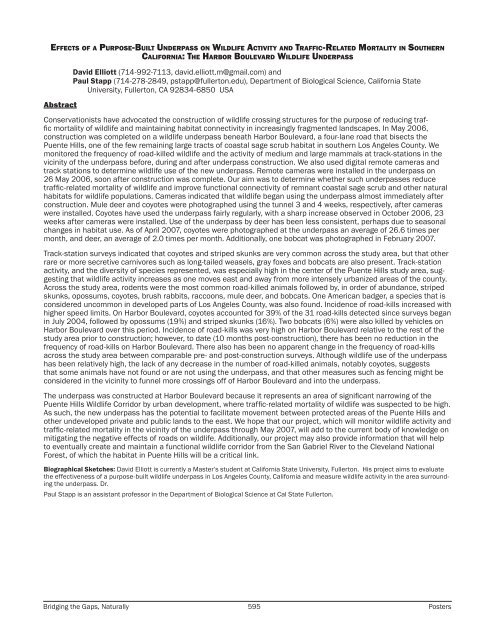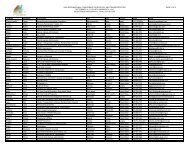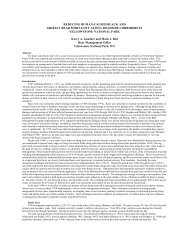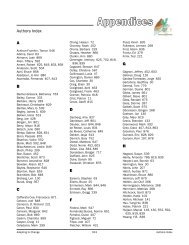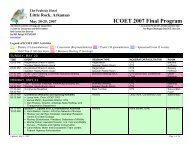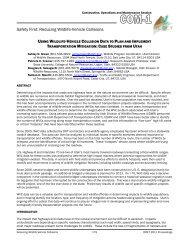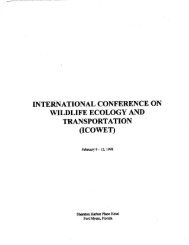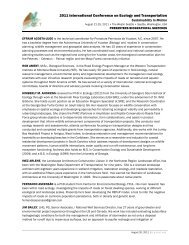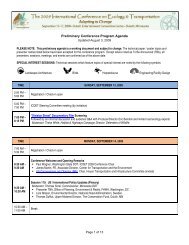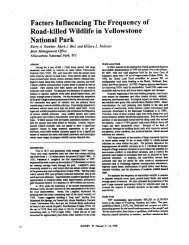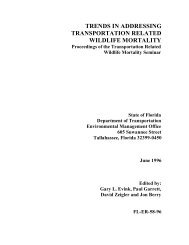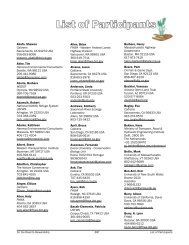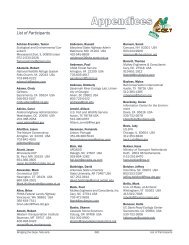Poster Sessions, pages 567-640 - ICOET
Poster Sessions, pages 567-640 - ICOET
Poster Sessions, pages 567-640 - ICOET
You also want an ePaper? Increase the reach of your titles
YUMPU automatically turns print PDFs into web optimized ePapers that Google loves.
Effects of a Purpose-Built Underpass on Wildlife Activity and Traffic-Related Mortality in Southern<br />
California: The Harbor Boulevard Wildlife Underpass<br />
Abstract<br />
David Elliott (714-992-7113, david.elliott.m@gmail.com) and<br />
Paul Stapp (714-278-2849, pstapp@fullerton.edu), Department of Biological Science, California State<br />
University, Fullerton, CA 92834-6850 USA<br />
Conservationists have advocated the construction of wildlife crossing structures for the purpose of reducing traffic<br />
mortality of wildlife and maintaining habitat connectivity in increasingly fragmented landscapes. In May 2006,<br />
construction was completed on a wildlife underpass beneath Harbor Boulevard, a four-lane road that bisects the<br />
Puente Hills, one of the few remaining large tracts of coastal sage scrub habitat in southern Los Angeles County. We<br />
monitored the frequency of road-killed wildlife and the activity of medium and large mammals at track-stations in the<br />
vicinity of the underpass before, during and after underpass construction. We also used digital remote cameras and<br />
track stations to determine wildlife use of the new underpass. Remote cameras were installed in the underpass on<br />
26 May 2006, soon after construction was complete. Our aim was to determine whether such underpasses reduce<br />
traffic-related mortality of wildlife and improve functional connectivity of remnant coastal sage scrub and other natural<br />
habitats for wildlife populations. Cameras indicated that wildlife began using the underpass almost immediately after<br />
construction. Mule deer and coyotes were photographed using the tunnel 3 and 4 weeks, respectively, after cameras<br />
were installed. Coyotes have used the underpass fairly regularly, with a sharp increase observed in October 2006, 23<br />
weeks after cameras were installed. Use of the underpass by deer has been less consistent, perhaps due to seasonal<br />
changes in habitat use. As of April 2007, coyotes were photographed at the underpass an average of 26.6 times per<br />
month, and deer, an average of 2.0 times per month. Additionally, one bobcat was photographed in February 2007.<br />
Track-station surveys indicated that coyotes and striped skunks are very common across the study area, but that other<br />
rare or more secretive carnivores such as long-tailed weasels, gray foxes and bobcats are also present. Track-station<br />
activity, and the diversity of species represented, was especially high in the center of the Puente Hills study area, suggesting<br />
that wildlife activity increases as one moves east and away from more intensely urbanized areas of the county.<br />
Across the study area, rodents were the most common road-killed animals followed by, in order of abundance, striped<br />
skunks, opossums, coyotes, brush rabbits, raccoons, mule deer, and bobcats. One American badger, a species that is<br />
considered uncommon in developed parts of Los Angeles County, was also found. Incidence of road-kills increased with<br />
higher speed limits. On Harbor Boulevard, coyotes accounted for 39% of the 31 road-kills detected since surveys began<br />
in July 2004, followed by opossums (19%) and striped skunks (16%). Two bobcats (6%) were also killed by vehicles on<br />
Harbor Boulevard over this period. Incidence of road-kills was very high on Harbor Boulevard relative to the rest of the<br />
study area prior to construction; however, to date (10 months post-construction), there has been no reduction in the<br />
frequency of road-kills on Harbor Boulevard. There also has been no apparent change in the frequency of road-kills<br />
across the study area between comparable pre- and post-construction surveys. Although wildlife use of the underpass<br />
has been relatively high, the lack of any decrease in the number of road-killed animals, notably coyotes, suggests<br />
that some animals have not found or are not using the underpass, and that other measures such as fencing might be<br />
considered in the vicinity to funnel more crossings off of Harbor Boulevard and into the underpass.<br />
The underpass was constructed at Harbor Boulevard because it represents an area of significant narrowing of the<br />
Puente Hills Wildlife Corridor by urban development, where traffic-related mortality of wildlife was suspected to be high.<br />
As such, the new underpass has the potential to facilitate movement between protected areas of the Puente Hills and<br />
other undeveloped private and public lands to the east. We hope that our project, which will monitor wildlife activity and<br />
traffic-related mortality in the vicinity of the underpass through May 2007, will add to the current body of knowledge on<br />
mitigating the negative effects of roads on wildlife. Additionally, our project may also provide information that will help<br />
to eventually create and maintain a functional wildlife corridor from the San Gabriel River to the Cleveland National<br />
Forest, of which the habitat in Puente Hills will be a critical link.<br />
Biographical Sketches: David Elliott is currently a Master’s student at California State University, Fullerton. His project aims to evaluate<br />
the effectiveness of a purpose-built wildlife underpass in Los Angeles County, California and measure wildlife activity in the area surrounding<br />
the underpass. Dr.<br />
Paul Stapp is an assistant professor in the Department of Biological Science at Cal State Fullerton.<br />
Bridging the Gaps, Naturally 595 <strong>Poster</strong>s


